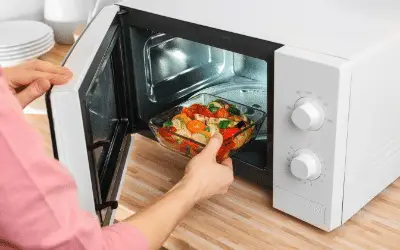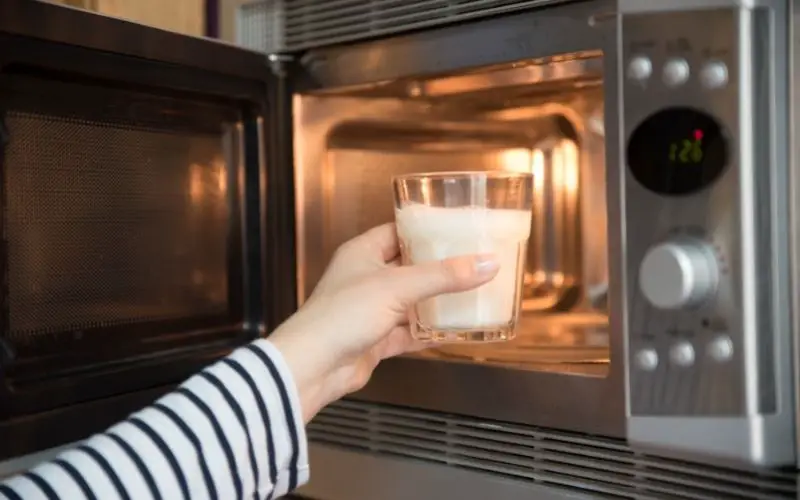Can You Microwave Glass Jars? (A Potential Hazard!)
We’ve all been through this. It’s late at night. You’re hungry. And, you’ve got some leftover food in a glass bowl or some soup in a mason jar and you want to heat it.
Can you microwave glass bowls?
Yes, you can microwave glass bowls. However, it’s important to keep in mind that not all glass bowls are created equal. There are glass bowls that are designed to be microwave-safe, while others are not.
Glass bowls made specifically for use in microwaves can withstand their high heat. They will not crack, melt, or release any substances when exposed to microwave radiation. Therefore, when using glass bowls in a microwave, it’s important to ensure that they’re marked as microwave-safe.
On the other hand, glass bowls that are not marked as microwave-safe may not withstand these high temperatures. They might break, crack, or, in some cases, even explode, potentially damaging your microwave and posing a safety risk.
For safety and practicality, it’s recommended to use only microwave-safe glass bowls in a microwave. In fact, many experts consider glass bowls to be safer for microwave use than plastic bowls, even high-quality ones, as glass tends not to leach any chemicals when heated.
Is it safe to microwave glass?
You can find a microwave oven in almost every single home in America. It’s a powerful machine that combines electricity with waves (specifically microwaves) and almost instantly cooks your food from the inside out. But there are certain things you just can’t put in a microwave. And the result of attempting to microwave anything reactive can be harmful.
Now, glass is a confusing option. There are different types of glass containers; some are microwave-safe, while others are not. In general, most modern glass containers that are microwave-safe are non-reactive and will have micro-waves passing through them. These materials won’t conduct heat directly from the waves.
Now if you do happen to microwave the wrong kind of glass (a nonmicrowave-safe one), there’s a likely chance that it will heat up quite rapidly. When it becomes too hot,it could shatter or explode. Shattering is one thing, but an explosion of glass isn’t going to end well for anyone close by.
Even with the microwave door closed, the explosion could cause it to burst open. There’s also the possibility that it will melt However, glass melts at approximately 1400 °C to 1600 °C. So, this is only if you’ve left it on for a very long time.
This video shows how a microwave can be used to melt glass.
And let’s not forget, if the food coming out of the microwave is piping hot, this could contribute to the glass breaking as well, which can cause serious burn injuries.
Why are some glass containers microwave-safe and others not?
The distinction between microwave-safe and non-microwave-safe glass containers stems from the materials used in their manufacture and their physical design. Microwave-safe glassware is specifically manufactured using materials that can withstand the intense heat and energy levels produced by microwaves without degrading. These materials do not absorb microwave energy, which means they won’t heat up as much as the food or liquid inside them.
For example, borosilicate glass, known for its thermal resistance, is a common material for microwave-safe containers; it can endure sudden temperature changes without cracking. Conversely, non-microwave-safe glass may contain tiny air bubbles or impurities like lead and minerals, which can absorb microwave energy, leading to uneven heating or even causing the glass to break under thermal stress.
Some glassware has metal paint or decorations that can spark and cause fires. An example of this distinction can be seen in Pyrex dishes made in the United States before the 1990s, which were made of borosilicate glass and were more resistant to thermal shock compared to later models made from tempered soda-lime glass that, while sturdy, is less tolerant to rapid temperature changes and thus requires more caution when used in microwaves.
How to tell if a glass container or jar is microwave-safe
- The Microwave-Safe Sign: This is typically a symbol located at the bottom of your glass container. You might see wavy lines, indicating the microwaves. If you spot this symbol, it’s likely that the container is safe for microwave use. Many times, the container will also explicitly state “microwave-safe.” If the sign is not on the container, check the original packaging or the manual. Should this information not be available, consider reaching out to the manufacturer for confirmation.
- The Microwave-Safe Test: For older containers without clear markings or when manufacturer information is unavailable, conduct this simple test. Place the empty container in the microwave alongside a cup of water (in a separate microwave-safe vessel). Heat them together for 1-2 minutes. If the glass container is warm or hot to the touch, it has absorbed microwave energy and is not safe for use. Conversely, if the container remains cool and only the water has heated, it is likely microwave-safe.
- Visual Inspection: Identifying if a glass container is microwave-safe can often be accomplished with a careful visual inspection. This process involves looking for any metallic trims or decorations that could pose a risk when microwaved. Metal in microwaves can cause sparks and potentially lead to fires, making any glassware with these elements unsuitable for microwave use. Additionally, checking for any damages, such as cracks or chips, is important; these flaws can compromise the integrity of the glass when exposed to microwave temperatures.
- Manufacturer’s Guidelines: The manufacturer’s guidelines are a direct source to determine if a glass container is microwave-safe. Most glassware comes with care instructions that clearly state its microwave compatibility. If you’ve lost the original packaging, this information is often available on the manufacturer’s website. Adhering to these guidelines ensures not only the safety of the glassware but also helps preserve its condition over time.
- Research the material: Finally, understanding the material of your glass container can offer insights into its suitability for microwave use. Borosilicate glass, known for its durability against temperature changes, is typically a safe choice for the microwave. In contrast, soda-lime glass, although common, is less tolerant to sudden heat and might not be the best option for microwaving. A quick assessment of the glass type can guide you in determining its microwave safety.
Safety precautions when you heat food in mason jars
- The jar could be made with metal parts. Almost everyone knows that you shouldn’t heat metal, and even if you didn’t know, your first experience with heating metal will scare you for life. However, some glass containers, like mason jars, for example, can have hidden metal components laced all around the rim of the opening. You don’t want to microwave these kinds of jars because they create sparks. Again, you can check with the above subtopic to find out how to identify if a container is microwave-safe or not.
- Never seal your glass containers when putting them in the microwave. This is an especially important concept to understand and not knowing can cause major injury.
When microwaving food in any kind of container, the food will react violently. This helps produce heat and even pressure. If you were to place food or water into a glass container and seal it with a lid, the extreme heat and pressure produced during the heating process would build up and cause the glass to explode. This is because glass doesn’t flex and that rigid structure simply causes the glass to either shatter or explode due to the pressure pushing outward. This is exactly what happened in the video below. Notice how the person in the video attempts to microwave a sealed glass bottle of beer.
- Always use protective gloves when handling containers coming out of a microwave: Even though the glass container you’re using doesn’t conduct heat from the microwaves, the thermal heat from the food will make the container hot to the touch. It’s recommended that you wear protective gear. This can be anything from heat-proof gloves, hot pads, or even a regular towel in place between your hands and the container. As an extra piece of advice, invest in hot plate coasters so that the heat won’t damage your tabletops like it did mine.
- Don’t microwave frozen food immediately in the microwave: When microwaving food that has been frozen, the food will expand almost immediately and cause immense pressure. In rare cases, even if you don’t have the lid on, the release of pressure can be so great that it can cause the glass to break anyway. When you’re faced with frozen food in a glass container, it needs to be defrosted. Some microwaves have a defrost button, which is a presetting that turns the microwave on and off in short time intervals, allowing the food to melt slowly and not too quickly like the regular process.
Rules for microwaving food in glass containers

- Check to see if the container is microwavable: Check around the container, original box, or manual and look for a microwave-safe symbol (usually designated in squiggly lines or having the image of a microwave). You can also look for any label you may find that says “microwave-safe.”.
- Thaw or defrost, if frozen: If there’s frozen food inside, make sure you thaw it in a water bath or set it under the microwave’s defrost setting. You can also manually microwave the frozen food in short intervals; however, I find it much easier just to use the defrost setting on your microwave because this is exactly what it does.
- Remove the lid: It doesn’t matter what type of container it really is. Don’t ever seal your container while microwaving it. The process of microwaving food or water involves building up a lot of heat and pressure. The unfortunate thing about glass is that it doesn’t bend or flex.
- Inspect the container for metal components: Some mason jars have a ring of metal around the opening. This immediately signifies that it’s not microwave safe and you should never microwave this glass container.
- Stir the food in between microwave intervals: It’s always a safe bet to stir your food in between microwaving intervals. This helps distribute the heat and even out the cooking processes. Microwave ovens don’t evenly cook food. I’ve written an article here about how engineers who invented the microwave had to develop an interesting workaround to help microwaves cook more evenly. It’s still being used today.
The bottom line
Glass containers and glass jars are incredibly rigid, meaning that they can’t simply flex or bend. Glass that is not microwave-safe has these tiny little air pockets that will eventually expand while being microwaved and this can cause it to shatter.
However, there are several other reasons you should watch out for, even if your glass container is microwavable, such as not using the lid, avoiding microwaving frozen food, etc.
It’s important to follow this guide because it can be very dangerous when not using a microwave correctly or placing the wrong things in the microwave.
Other interesting articles:
